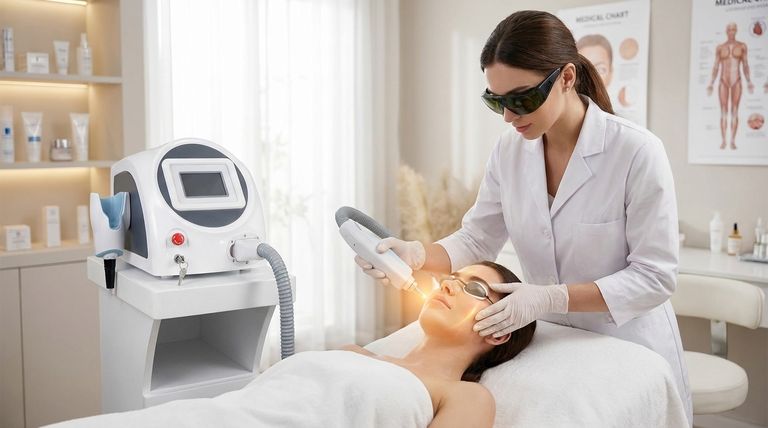Yes, YAG lasers can significantly improve the skin. They work by delivering focused light energy into the skin, which stimulates the body's natural healing processes. This leads to increased collagen production, enhanced skin elasticity, and an overall improvement in skin tone and texture.
The term "YAG laser" refers to a category of lasers, not a single device. The specific improvement you see depends entirely on which type of YAG laser is used—ablative lasers that resurface the skin or non-ablative lasers that work on deeper tissues.

How YAG Lasers Rejuvenate Skin
A YAG laser operates on a principle called selective photothermolysis. In simple terms, the laser emits a specific wavelength of light that is absorbed by a target, or chromophore, within the skin.
These targets can be melanin (pigment), hemoglobin (in blood vessels), or water. When the target absorbs the light energy, it converts to heat, creating a controlled thermal effect that triggers a regenerative response from the skin.
The Two Primary Types of YAG Lasers
Understanding the difference between the two main types of YAG lasers is crucial, as they address entirely different concerns.
The Nd:YAG Laser (1064nm): Targeting Deeper Tissues
The Neodymium-doped Yttrium Aluminum Garnet (Nd:YAG) laser uses a longer wavelength of 1064nm. This allows it to penetrate deeper into the skin without harming the surface.
This laser is non-ablative, meaning it does not remove the outer layer of skin. Its energy is absorbed by deeper targets like pigment and hemoglobin.
It is highly effective for treating pigmented lesions like sun spots, reducing visible facial veins, and performing laser hair removal. By gently heating the dermis, it can also stimulate collagen for subtle skin tightening over a series of treatments.
The Er:YAG Laser (2940nm): Resurfacing the Surface
The Erbium-doped Yttrium Aluminum Garnet (Er:YAG) laser uses a 2940nm wavelength. This wavelength is intensely absorbed by water molecules within skin cells.
This makes the Er:YAG an ablative laser. It works by instantly vaporizing thin, precise layers of skin from the surface.
This resurfacing action is ideal for treating surface-level imperfections like fine lines, deeper wrinkles, acne scars, and textural irregularities. The removal of old, damaged skin reveals the newer, healthier skin underneath and powerfully stimulates new collagen growth during the healing phase.
Understanding the Trade-offs and Considerations
While effective, YAG laser treatments involve important trade-offs that you must consider before proceeding.
Downtime and Recovery
A non-ablative Nd:YAG treatment typically involves little to no downtime. You may experience mild redness for a few hours.
An ablative Er:YAG treatment requires significant downtime. The recovery period can range from one to two weeks, involving redness, swelling, and peeling as the skin heals.
Results Are Not Instantaneous
For both laser types, the most significant results come from new collagen production. This is a biological process that takes time.
While you may see initial changes, the full benefits of improved texture and firmness can take 3 to 6 months to become fully apparent.
Skin Type and Safety
The 1064nm Nd:YAG is generally considered a safer option for individuals with darker skin tones because its longer wavelength is less likely to be absorbed by melanin in the epidermis, reducing the risk of pigmentary changes.
Ablative lasers like the Er:YAG carry a higher risk of post-inflammatory hyperpigmentation (PIH) in darker skin and require expert administration to minimize complications.
Making the Right Choice for Your Goal
The best YAG laser treatment is the one that directly matches your specific skin concern and tolerance for downtime.
- If your primary focus is reducing pigmentation, redness, or unwanted hair with minimal downtime: A non-ablative Nd:YAG laser is the most effective tool for the job.
- If your primary focus is correcting deep wrinkles, acne scars, or significant textural damage: An ablative Er:YAG laser provides a more powerful and transformative resurfacing treatment.
- If your primary focus is mild, overall skin firming and rejuvenation: A series of non-ablative Nd:YAG treatments can effectively stimulate collagen over time.
Consulting a board-certified dermatologist or plastic surgeon is the critical next step to determine the ideal treatment plan for your skin.
Summary Table:
| Laser Type | Wavelength | Primary Action | Ideal For | Downtime |
|---|---|---|---|---|
| Nd:YAG | 1064nm | Non-ablative (heats deeper tissue) | Pigmentation, redness, hair removal, mild tightening | Minimal to none |
| Er:YAG | 2940nm | Ablative (resurfaces skin) | Wrinkles, acne scars, textural issues | 1-2 weeks |
Ready to transform your skin with professional YAG laser technology?
BELIS specializes in providing advanced medical aesthetic equipment to clinics and premium beauty salons. Our YAG laser systems are designed to deliver safe, effective, and customizable treatments for your clients' specific skin concerns.
Contact our experts today to learn how our reliable technology can enhance your service offerings and drive your business growth.
Visual Guide

Related Products
- Q Switch Nd Yag Laser Machine Tattoo Removal Nd Yag Machine
- Clinic Use IPL and SHR Hair Removal Machine with Nd Yag Laser Tattoo Removal
- Hydrofacial Machine with Facial Skin Analyzer and Skin Tester
- Hydrafacial Machine Facial Clean Face and Skin Care Machine
- Pico Picosecond Laser Machine for Tattoo Removal Picosure Pico Laser
People Also Ask
- How does the Nd:YAG laser work? Unlocking Deep-Tissue Precision for Medical Aesthetics
- How long does it take to recover from Nd:YAG laser treatment? A Timeline for Every Procedure
- How much does a laser tattoo removal machine cost? Choose the Right Tech for Your Clinic
- What are the disadvantages of Q switching? Trade-offs in Pulse Control, Cost, and Beam Quality
- What are Q-switched lasers commonly used for? Remove Tattoos & Pigment with Precision



















